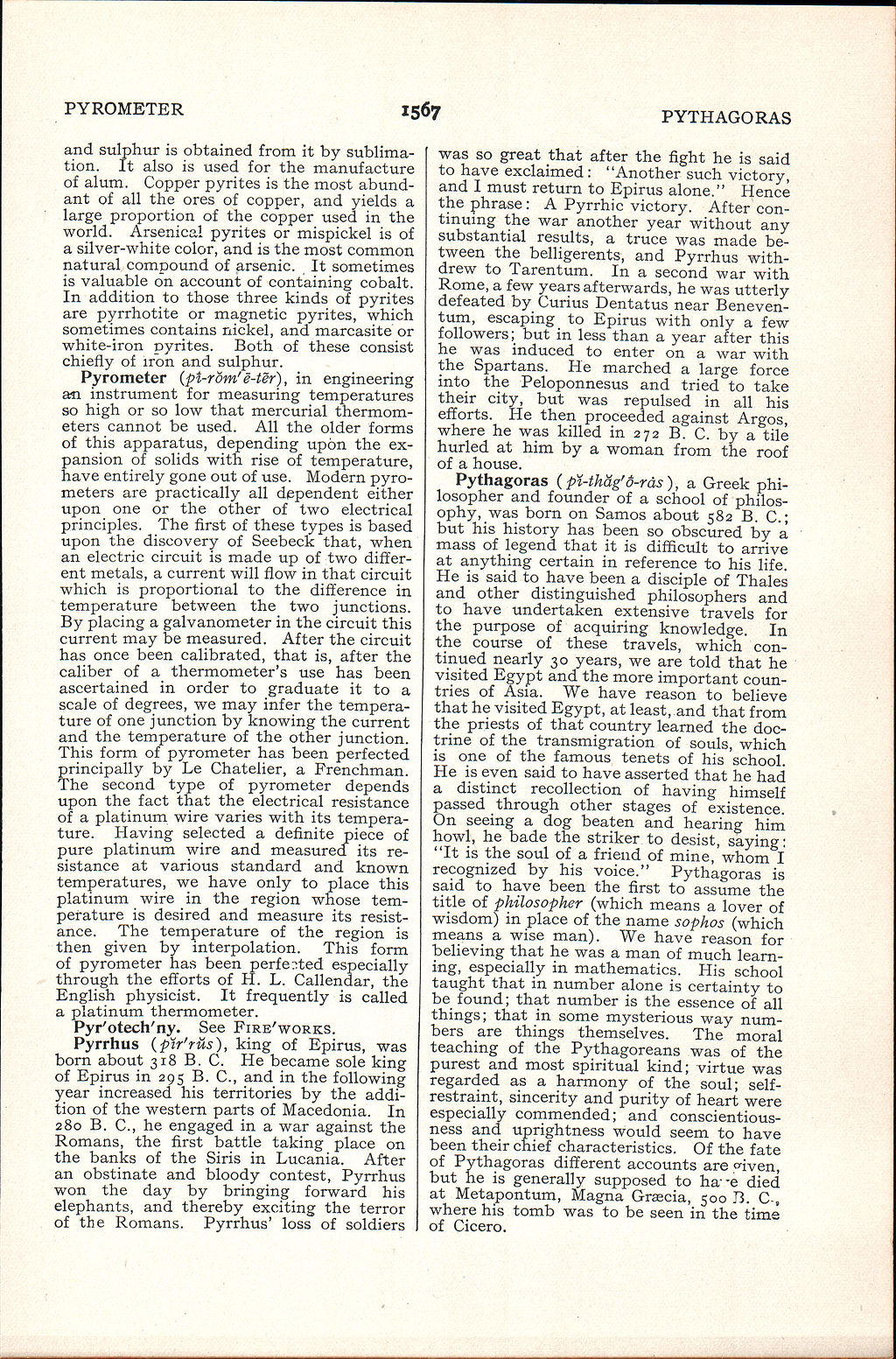PYROMETER
1567
PYTHAGORAS
and sulphur is obtained from it by sublimation. It also is used for the manufacture of alum. Copper pyrites is the most abundant of all the ores of copper, and yields a large proportion of the copper used in the world. Arsenical pyrites or mispickel is of a silver-white color, and is the most common natural compound of arsenic. It sometimes is valuable on account of containing cobalt. In addition to those three kinds of pyrites are pyrrhotite or magnetic pyrites, which sometimes contains nickel, and marcasite or white-iron pyrites. Both of these consist chiefly of iron and sulphur.
Pyrometer (pi-row! e-ter}, in engineering an instrument for measuring temperatures so high or so low that mercurial thermometers cannot be used. All the older forms of this apparatus, depending upon the expansion of solids with rise of temperature, have entirely gone out of use. Modern pyrometers are practically all dependent either upon one or the other of two electrical principles. The first of these types is based upon the discovery of Seebeck that, when an electric circuit is made up of two different metals, a current will flow in that circuit which is proportional to the difference in temperature between the two junctions. By placing a galvanometer in the circuit this current may be measured. After the circuit has once been calibrated, that is, after the caliber of a thermometer's use has been ascertained in order to graduate it to a scale of degrees, we may infer the temperature of one junction by knowing the current and the temperature of the other junction. This form of pyrometer has been perfected principally by Le Chateiier, a Frenchman. The second type of pyrometer depends upon the fact that the electrical resistance of a platinum wire varies with its temperature. Having selected a definite piece of pure platinum wire and measured its resistance at various standard and known temperatures, we have only to place this platinum wire in the region whose temperature is desired and measxire its resistance. The temperature of the region is then given by interpolation. This form of pyrometer nas been perfected especially through the efforts of H. L. Callendar, the English physicist. It frequently is called a platinum thermometer.
Pyr'otech'ny. See FIRE'WORKS. Pyrrhus (pWrus}, king of Epirus, was born about 318 B, C. He became sole king of Epirus in 295 B. C., and in the following year increased his territories by the addition of the western parts of Macedonia. In 280 B. C., he engaged in a war against the Romans, the first battle taking place on the banks of the Siris in Lucania. After an obstinate and bloody contest, Pyrrhus won the day by bringing forward his elephants, and thereby exciting the terror of the Romans. Pyrrhus' loss of soldiers ,
was so great that after the fight he is said to have exclaimed: "Another such victory, and I must return to Epirus alone." Hence the phrase: A Pyrrhic victory. After continuing the war another year without any substantial results, a truce was made between the belligerents, and Pyrrhus withdrew to Tarentum. In a second war with Rome, a few years afterwards, he was utterly defeated by Curius Dentatus near Beneven-tum, escaping to Epirus with only a few followers; but in less than a year after this he was induced to enter on a war with the Spartans. He marched a large force into the Peloponnesus and tried to take their city, but was repulsed in all his efforts. He then proceeded against Argos, where he was killed in 272 B. C. by a tile hurled at him by a woman from the roof of a house.
Pythagoras (pt-thag'o-ras), a Greek philosopher and founder of a school of philosophy, was born on Samos about 582 B. C.; but his history has been so obscured by a mass of legend that it is difficult to arrive at anything certain in reference to his life. He is said to have been a disciple of Thales and other distinguished philosophers and to have undertaken extensive travels for the purpose of acquiring knowledge. In the course of these travels, which continued nearly 30 years, we are told that he visited Egypt and the more important countries of Asia. We have reason to believe that he visited Egypt, at least, and that from the priests of that country learned the doctrine of the transmigration of souls, which is one of the famous tenets of his school. He is even said to have asserted that he had a distinct recollection of having himself passed through other stages of existence. On seeing a dog beaten and hearing him howl, he bade the striker to desist, saying: "It is the soul of a friend of mine, whom I recognized by his voice." Pythagoras is said to have been the first to assume the title of philosopher (which means a lover of wisdom) in place of the name sophos (which means a wise man). We have reason for believing that he was a man of much learning, especially in mathematics. His school taught that in number alone is certainty to be found; that number is the essence of all things; that in some mysterious way numbers are things themselves. The moral teaching of the Pythagoreans was of the purest and most spiritual kind; virtue was regarded as a harmony of the soul; self-restraint, sincerity and purity of heart were especially commended; and conscientiousness and uprightness would seem to have been their chief characteristics. Of the fate of Pythagoras different accounts are oiven, but he is generally supposed to ha^e died at Metapontum, Magna Grsecia, 500 B. C-9 where his tomb was to be seen in the time of Cicero.
